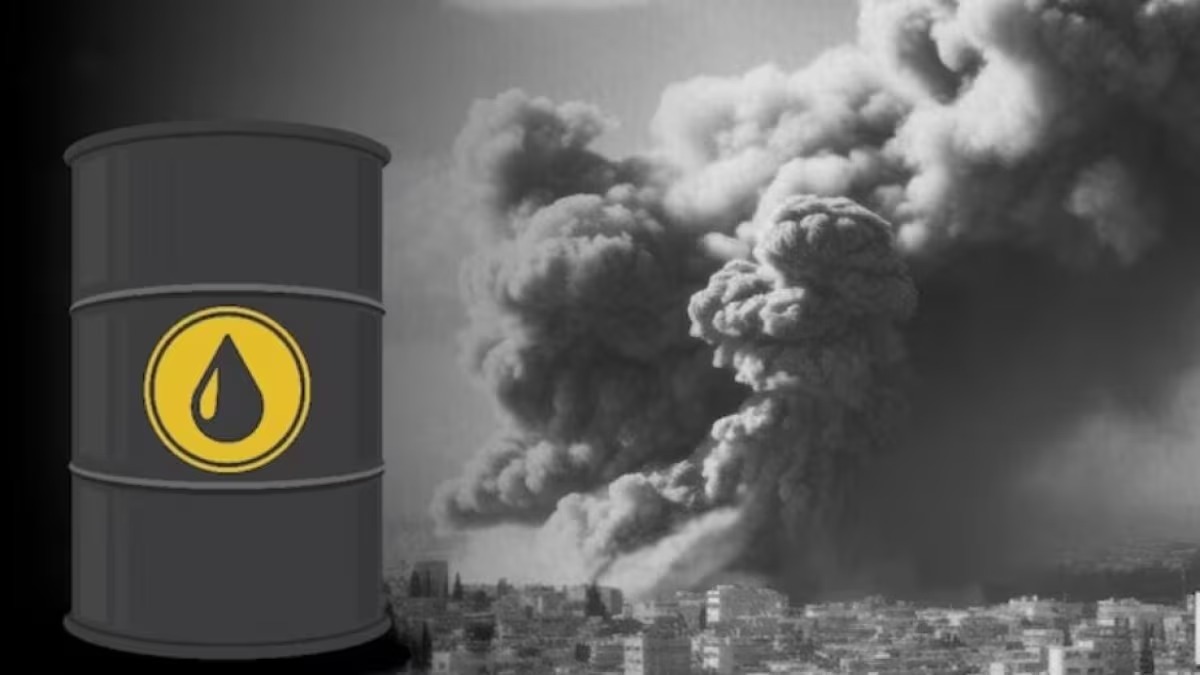Today Sees Major Market Upheaval, Nifty Slides 1%, Rs 6 Lakh Crore Wiped Out As Sensex Slips 1%
The Israel-Iran conflict has sharply escalated and has raised fears of a broader regional war, with both sides exchanging cross-border strikes and the U.S. stepping in to support Israel’s defense. As the conflict now threatens to draw in other global powers and destabilize the region further, the geopolitical tension has caused a sharp downturn in global markets, with Indian benchmark indices opening lower on Thursday. The Sensex plunged over 1,250 points, while the Nifty50 slipped below the 25,500 mark, reflecting investor anxiety as the conflict escalates. Rising oil prices amid the conflict pose a further challenge for import-dependent economies like India.

Nifty, Sensex Slide
The Israel-Iran conflict has escalated dramatically in October 2024.
Tensions between the two countries have been simmering for years, but recent developments have intensified the situation.
On October 1, Iran launched around 200 ballistic missiles at Israel in retaliation for the killing of Hezbollah’s Secretary General Hassan Nasrallah, which Israel had carried out a few days earlier. The missile barrage marked a significant escalation, leading Israel to vow retaliation against Iran.
Hence, fears of an escalating conflict in the Middle East have sparked concerns over potential disruptions to oil supplies from the region.
As tensions rose, global markets reacted swiftly. Indian benchmark indices opened sharply lower on Thursday, with the Sensex plummeting over 1,250 points, and the Nifty50 falling below the 25,500 level, reflecting the risk-averse sentiment seen across Asian markets.
By 9:16 am, the BSE Sensex had dropped 1,264 points (1.5%) to 83,002, while the Nifty50 was down 344 points (1.33%), trading at 25,452. The total market capitalization of listed companies on the BSE shrank by Rs 5.63 lakh crore, bringing it to Rs 469.23 lakh crore.
Oil prices edged up due to fears of supply disruptions, posing a challenge for import-dependent countries like India, where crude imports significantly impact the economy.
In early trade, the Nifty Oil & Gas index declined by 1.2%, with Hindustan Petroleum, Indian Oil Corporation (IOC), and GSPL leading the losses.
Among the Sensex pack, top contributors to the index’s fall included Reliance Industries, HDFC Bank, ICICI Bank, M&M, L&T, and Bharti Airtel, while JSW Steel and Tata Steel bucked the trend and opened higher.
Meanwhile, India’s volatility index, the India VIX, spiked by 8.9%, reaching 13.06, indicating heightened market anxiety.

What Has Happened So Far
Israel has been engaged in military operations not only against Iran but also Hezbollah in Lebanon.
These operations have intensified with Israel targeting key Hezbollah infrastructure, leading to further violence from Hezbollah forces stationed along the Israel-Lebanon border.
Hezbollah, backed by Iran, has also been involved in cross-border attacks into Israel, escalating the conflict further. Both sides are conducting aerial and ground attacks, with Israel’s Iron Dome system intercepting many of the incoming missiles.
The U.S. has expressed support for Israel’s defense but has opposed any potential Israeli strike on Iran’s nuclear facilities, warning that such actions could drag the region into a broader war. U.S. military forces in the region have also assisted in intercepting some of the missile attacks on Israel.
This conflict, already involving proxy forces like Hezbollah and Hamas, poses a serious risk of drawing in other regional and global powers into a more extensive confrontation.

Indian Stock Markets Bleed
Here are the key factors behind today’s market meltdown:
Iran-Israel Clash: Indian stocks plummeted on Thursday due to rising concerns over escalating hostilities between Iran and Israel. This follows Iran’s missile strikes on Tel Aviv, which led to Israeli military operations in southern Lebanon, resulting in the deaths of eight Israeli soldiers. Israel has warned of a potential retaliation, deepening regional tensions and unsettling global markets.
Rise in Crude Oil Prices: Fears of disrupted oil supplies from the Middle East amid the conflict pushed oil prices higher. Brent crude briefly crossed $75 per barrel, while West Texas Intermediate (WTI) surged past $72, both rising nearly 5% in just three days. A spike in oil prices is particularly detrimental for oil-importing countries like India, as crude imports significantly impact the economy.
SEBI Tightens F&O Measures: India’s market regulator SEBI has introduced tighter rules in the futures and options (F&O) segment, which has also contributed to the market decline. New measures, such as restricting weekly expiries to one per exchange and increasing contract sizes, are likely to dampen retail trading sentiment and reduce volumes, adding to broader investor concerns amid geopolitical tensions.
China: Investor anxiety has also been fueled by the recent recovery of Chinese stocks following government stimulus measures. The Shanghai Stock Exchange (SSE) Composite index surged 8% on Tuesday and has risen over 15% in the past week. This has led to significant foreign outflows from Indian equities, with Rs 15,370 crore being withdrawn by foreign institutional investors in the past two days.
These combined factors—geopolitical uncertainty, rising oil prices, tighter regulations, and competition from Chinese markets—have all contributed to the sharp downturn in Indian equity markets today.

Oil Rises as Middle East Conflict Deepens, But Gains Capped by Global Supply Outlook
Oil prices edged higher on Thursday as investors evaluated the escalating conflict between Israel and Iran, weighing the potential disruption to crude flows against an otherwise well-supplied global market.
Brent crude futures rose by 64 cents (0.87%) to $74.54 per barrel, while U.S. West Texas Intermediate (WTI) futures climbed 72 cents (1.03%) to $70.82.
However, an unexpected increase in U.S. crude inventories, which rose by 3.9 million barrels in the week ending Sept. 27, eased some supply concerns, keeping price gains in check. The Energy Information Administration (EIA) reported this inventory rise, surpassing analysts’ expectations of a 1.3 million-barrel decline.
“Swelling U.S. inventories indicate that the market is well supplied and can withstand any short-term disruptions,” noted ANZ analysts.
Despite the conflict, global crude supplies have not been disrupted, and OPEC’s spare capacity continues to temper investor worries.
According to Jim Simpson, CEO of East Daley Analytics, “Although prices may stay elevated or volatile due to Iran’s attack, there’s enough global supply to meet demand.” OPEC’s available capacity could compensate for the full loss of Iranian supply if Israel targets Iran’s oil facilities.
However, analysts remain concerned about further escalation. Giovanni Staunovo from UBS warned that if Iran retaliates by targeting Gulf neighbors’ oil infrastructure, OPEC’s spare capacity may struggle to meet the demand.

A Full-Scale Israel-Iran War Could Threaten India’s Oil Security
Despite an increase in oil imports from Russia, India remains heavily reliant on oil and gas imports from the Middle East. In August, Russian oil accounted for approximately 36% of India’s imports, down from around 44% in July.
Conversely, the share of Middle Eastern oil in India’s crude imports rose to 44.6% in August, up from 40.3% the previous month. Key suppliers from the region include Iraq, Saudi Arabia, the UAE, and Kuwait.
India imports nearly half of its liquefied natural gas (LNG) from Qatar, and in February, the country secured a $78 billion deal to extend LNG imports from Qatar for another two decades.
Potential Disruptions to Energy Flows
The risk of a full-scale conflict between Iran and Israel poses a significant threat to India’s energy imports. If such a war breaks out, Iran’s allies, including Hezbollah and the Houthis, may intensify their attacks. Crucial oil shipping routes, notably the Red Sea and the Strait of Hormuz, could be disrupted.
India currently imports oil from Russia via the Red Sea; in the event of escalated conflict, shipments might need to reroute around the Cape of Good Hope, significantly increasing transport times and costs.
The blockage of the Strait of Hormuz is particularly concerning, as it is vital for India’s LNG and oil imports from Qatar, Iraq, and Saudi Arabia. According to the U.S. Energy Information Administration (EIA), the Strait of Hormuz is the world’s most important oil transit chokepoint, facilitating a substantial volume of global oil shipments.
In 2022 and the first half of 2023, China, India, Japan, and South Korea accounted for 67% of the crude oil and condensate transported through this strategic waterway. Given that two-thirds of India’s oil and half of its LNG imports pass through the Strait of Hormuz, any disruption could have severe consequences.

Economic Implications of Rising Oil Prices
Disruptions in oil and gas supplies could destabilize India’s economy, leading to increased inflation and preventing the Reserve Bank of India (RBI) from lowering interest rates as anticipated by year-end.
With many industries relying on imported energy, any spike in oil and gas prices could stifle growth and drive inflation, which had been declining recently. The government’s substantial fuel subsidies might also necessitate a reevaluation of public spending, particularly in infrastructure projects, and could affect the fiscal deficit trajectory.
According to a report by Morgan Stanley, a $10 increase in crude oil prices could raise consumer prices across Asian economies by 0.2 to 1.4 percentage points, with India projected to experience a 0.5 percentage point increase in its Consumer Price Index (CPI) for each $10 per barrel rise.
In August 2024, India’s oil imports fell sharply by 32.4% year-on-year, attributed to a significant drop in global crude oil prices, as reported by Crisil. This decline marks the third consecutive month of reduced imports, with Brent crude averaging $80.9 per barrel in August 2024, down from $86.2 per barrel a year earlier.
Indian oil marketing companies (OMCs) are benefiting from this trend, as their profits have surged alongside falling crude prices, leading to speculation about potential cuts in consumer fuel prices.
Pankaj Jain, secretary at the Ministry of Petroleum and Natural Gas, indicated that OMCs would consider reducing fuel prices if low crude oil prices persist.
Recent reductions in crude oil prices have improved margins on retail auto fuels, allowing state-owned firms the potential to lower petrol and diesel prices by Rs 2-3 per litre, according to the rating agency Icra. However, if a war were to erupt, OMCs might be unable to cut prices and could instead face pressure to raise them.
ICRA estimates that India’s net oil import bill could increase to $101-104 billion in the current fiscal year, up from $96.1 billion in 2023-24. Any escalation in the Iran-Israel conflict may exert upward pressure on import values.
The agency calculates that a $10 per barrel rise in average crude oil prices could increase net oil imports by $12-13 billion for the year, potentially expanding the current account deficit (CAD) by 0.3% of GDP.
As India imports most of its oil in dollars, higher oil prices could lead to rupee depreciation, raising overall import costs and further widening the CAD.




